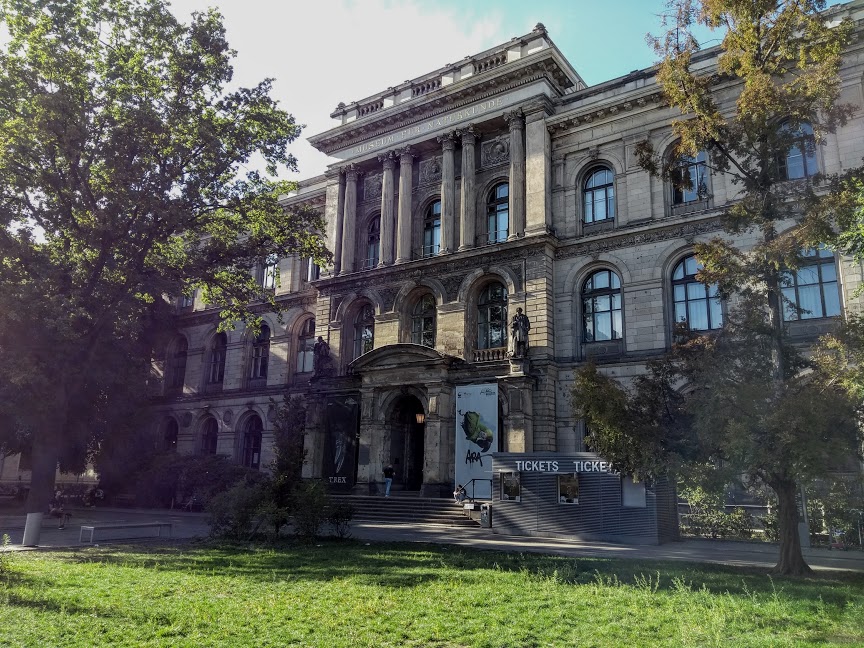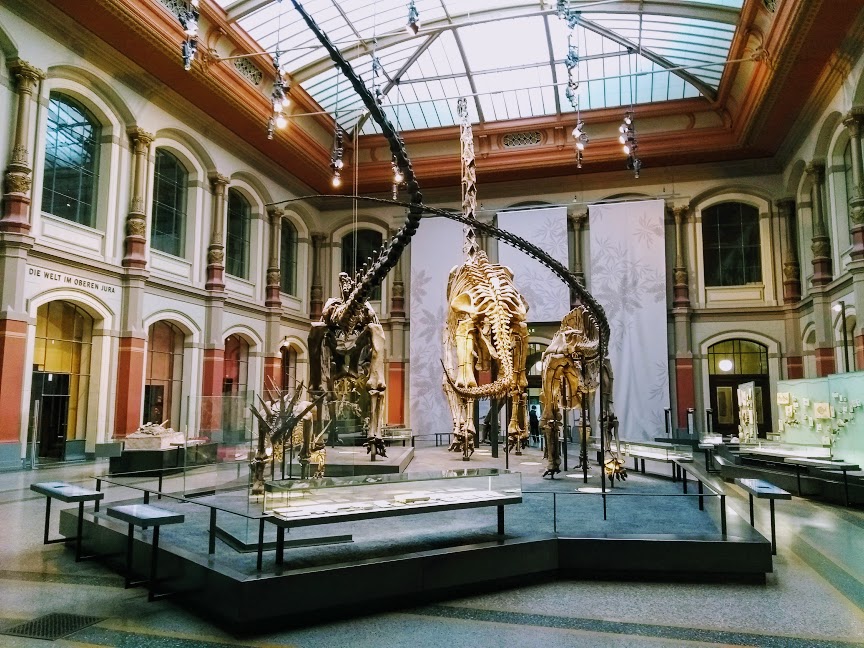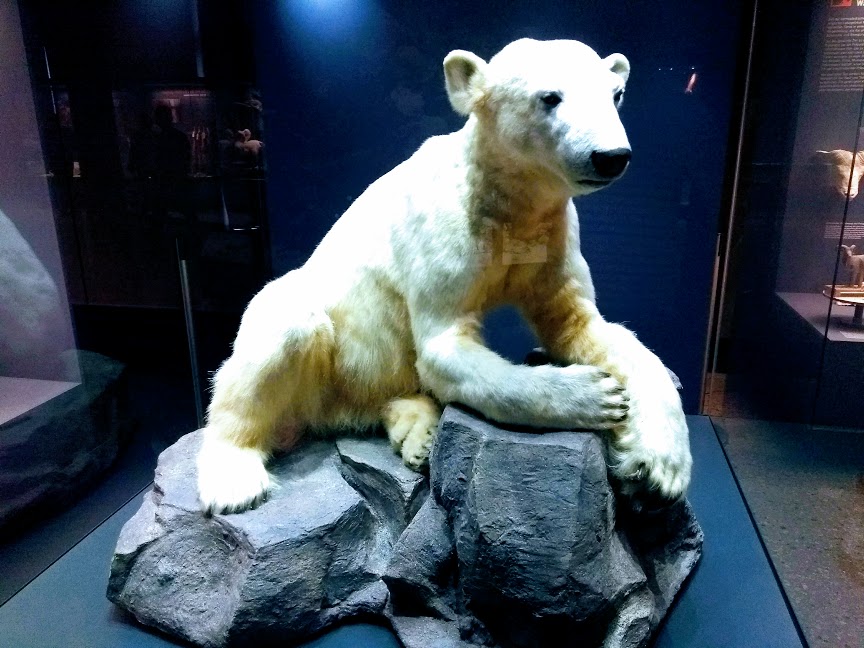Berlin’s Museum of Natural History: Dinosaurs and Dark Tourism
When I read about the destruction of Brazil’s Natural History Museum by fire on 2 September–– and the loss of its 20-million object collection––it occurred to me that I have never visited Berlin’s own Naturkundemuseum. How many residents of Rio had also never visited their 200-year old institution? How many wish they had?

Berlin’s collection (founded 1810) is about the same age as Rio’s and slightly larger (with 30 million items). It has a number of draw cards: the largest mounted dinosaur in the world, the best preserved fossil of the oldest known bird, and one of the world’s best skeletons of a Tyrannosaurus rex. It’s unimaginable, now having visited, to imagine this place engulfed by flames. In fact, it almost was; the Naturkundemuseum is a lucky survivor of World War Two bombing, and the first East Berlin museum to reopen after the war.
I approach the institution on Invalidenstraße from the nearby metro station. Until 2009, the metro was called Zinnowitzer Straße. And a friend once jokingly told me––my German at that time in development and unfortunately easily influenced––that “Zinnowitzer” is the German name for a nose-hair trimmer. It’s just as well they changed the name to, now, sensibly, “Naturkundemuseum”.

Invalidenstraße can be windy and inhospitable, so it’s encouraging to know I’ve arrived, seeing the monumental façade, with the words: “Museum für Naturkunde” engraved on the entablature. The neoclassical building was opened in 1889, during a Prussian flurry of investment in institutions of learning (it is contemporary, and similar in style and design, to the Berlin University of the Arts building (or former Joachimsthalsche Gymnasium) on Bundesallee, for example). Affiliated with the Humboldt University through the East German period, and after reunification, it became its own foundation and member of the Leibniz Foundation in 2009.
Inside the front doors, it certainly feels more like an academic institution than a slick tourist attraction. There are plenty of hallways in need of paint jobs, locked doors, dead ends, windows into empty rooms, hallways full of wooden boxes for exhibits being mounted or dismounted, and offices for researchers full of drawers and stuffed lizards. The enormous biodiversity section appears organised for research and teaching. In the minerals collection––with its enormous crystals––the objects are kept in old-school wooden cases, as so many curiosity cabinets. And perhaps this is what I like most about this museum compared to––say––its London and Vienna cousins. The Naturkundemuseum is a working place, and one that doesn’t hide its research under an ostentatiously curated skin. Here, you see the institution’s skeleton.

When you walk into the main atrium, the world’s largest mounted dinosaur rises before you, its head dizzy at the rafters. It’s a Giraffatitan, or “giant giraffe”, a name that might seem strange for a lizard, until you see it. Found in Tendaguru, Tanzania––at the time German East Africa––the specimen is (arguably?) a piece of colonial loot, collected before the First World War. Around it are a number of other terrifying creatures, of varying capable speeds, diets, and deadliness. In 2007, there were major improvements made to the main atrium space––which required a dismantling of the dinosaurs, and I imagine the courtyard full of bones. I find this just one of many not reassuring places in the museum. And, of course, it is full of children.
While the Giraffatitan takes your breath away, the Archaeopteryx––the fossil of the oldest known bird, collected in 1874––is only about the size of a hand, and requires attention to detail. Apparently, a Bavarian farmer didn’t fully appreciated what he was handling when he discovered it in a quarry, and he sold it for just enough money to buy himself a cow; only five years later was it acquired by the museum for 20 000 Goldmark. Kept in a small niche, the bird seems mutant to modern eyes––half-reptile, half-avian––reminding us how close the two taxonomic classes really are. It is splayed on its back, twisted, and crushed, and has survived in this state for some 125-150 million years.

“Tristan Otto”, meanwhile, can be seen around the corner, to the left, after the meteorites and astronomy exhibits. He is one of the best preserved Tyrannosauri reges in the world, the only one displayed in Europe, and has definitely the best preserved skull (the original is kept in a separate case, and so can be approached with trepidation, close-up).
Tristan is a huge, blackened, disconcerting, affair. He must have been pretty nasty too: he suffered from a tumour in his jaw (you can see the damage), and with an overlong tooth he had a permanent toothache. I imagine him as a testy son-of-a-bitch. Meanwhile, the exhibit taunts you with terrifying questions, such as “how does his skull withstand the pressure of his enormous biting jaws?”
Tristan is only on loan to the museum, and has an unusual provenance. Discovered in 2010 in Montana, Tristan was bought by a Danish banker, Niels Nielsen. Some bankers buy yachts or invest in cryopreservation, but Nielsen happened really to like dinosaurs as a kid, and so when he had a big seven figures on hand to spend, he went out and bought himself a T-Rex. There is a problem, however, with acquiring a T-Rex, and that is where to keep it. As Nielsen put it himself, “It is too big to have at home”.
Unable to display domestically his excellent conversation piece, Nielsen went for a museum instead. Based in London, Nielsen would have liked to have had Tristan close-at-hand at the city’s Natural History Museum. He could have visited it at lunch (do bankers have time for lunch?). But that institution turned him down, so Tristan––lucky for us–– flew instead to Berlin. But hurry up, the loan is temporary.

Dinosaurs terrify me: because they are so old, big, lethal… because their extinction seems to presage our own. But there are more recently deceased superstars just down the hall. The museum must have an arrangement with the Berlin zoo, because two of its famous, and now dead, occupants, are now stuffed here: Bao Bao the panda, and Knut the polar bear.
I remember visiting Bao Bao when I first moved to Berlin, and being horrified by how small the cage was he occupied (the importance of the Panda has since risen, given its centrality to Chinese diplomacy, and the size of the panda enclosure has grown proportionally). Bao Bao, now dead, occupies a much larger space in the museum than he ever did while alive in the zoo. Two spaces, in fact, because Bao Bao has been skeletonised: one for his bones, and one for his huggable diachromatic form.
Across the room is Knut, looking perplexed, or simply stunned by the attack of encephalitis that caused him to drown in his zoo enclosure at the age of four. I approach––the room is still full of children––and remember his fame as the baby polar bear who was rejected by his mother and brought up by humans in captivity. His guard, Thomas Dörflein, slept alongside the cute fur-ball, feeding him by a bottle, and playing him his guitar, while outside the zoo gates animal rights activists suggested it was cruel for the animal to be raised by humans, and argued Knut should be put down. Knut, tiny and cute, became the centre of a phenomenon known as “Knutmania”, with children demonstrating for Knut’s life (and participating in the simultaneous market craze of a TV specials and polar-bear souvenirs, or the faux-fur “Knutbuger” registered as a trademark by the zoo). So, after this hullabaloo, I was surprised to find Knut stuffed into a distant corner of the museum, where nobody seems especially interested in him anymore. I suppose he looks older now. And even Dörflein would complain later that Knut would bite and shit everywhere. And, of course, now he is dead. Like so many other nameless polar bears swimming in the melting Arctic.

The creepiest place in the museum, however, is behind a door that requires you press a special button. The space behind is temperature controlled (read: cold) and dark, an enormous fridge, in which there is the museum’s remarkable “wet collection”, or a million creatures kept in 270 000 glass jars in an enormous two or three-story display pavilion, lit from within. Everything here is floating in liquid and bleached. “Icky” is the correct word. Jar after jar of leathery death. I imagine Eliot’s Sibyl floating in one of these containers and asking to die. The collection is, of course, of great scientific importance, but if you send a non-scientist with a fear of mortality in here (like myself) and a dislike for the smell of formaldehyde, then expect to find him scrambling to find the door out.
I find a side-door at the bottom of a stairwell, where the guards are outside smoking their cigarettes. One tells me, “If you get tired of photographing the dinosaurs, I’m always available”. But, although enticed by the offer, I’m quite ready to leave. For kids, this place is perhaps an emporium of colourful stuffed animals, a modified toy store, a zoo with fewer smells and happier creatures. But to adults who are old enough to have just a little glimpse of the terror of time, it is an invaluable, immense graveyard of so many things we have lost or are just about to lose.
–Joseph Pearson, 09/18


Yes, I was advised to visit the Naturkundemuseum over Christmas – I was specifically advised to take a tour around ‘the wet collection’.
What can I say? It is not why I am aiming to move to Berlin this spring – put it that way. However, I did like the experience. It was somewhat unexpected and the mixture of things going on in that museum is definitely an experience.
To be continued.
//LL